This paper adds to the strand of research that examines whether managers can strategically use their wording through specific linguistic devices. I define 'tone management' more broadly than just sentiment, incorporating the forward-looking intensity (FLI), and the linguistic complexity of conference calls, which are recognized as key drivers of qualitative information. I contribute to the existing literature in three ways. First, by taking advantage of recent innovations in machine learning and employing Bidirectional Encoder Representations from Transformers (BERT) for financial context texts, i.e., Financial Analysis with BERT (FinBERT) for sentiment and forward-looking intensity analysis, this study delves deeper into the qualitative content of conference calls and improves the understanding of tone management. Furthermore, by examining the differences between earnings and M&A conference calls as well as between sections of these calls, I shed light on the dynamics of qualitative information in different contexts, which has received limited attention in prior research. Finally, by studying the effect of the aforementioned linguistic devices on bid-ask spreads, this study contributes to the bid-ask spread literature by providing insights into the impact of qualitative information on firms’ information environment and market dynamics.
Inhaltsverzeichnis (Table of Contents)
- 1 Introduction
- 2 Conceptual
- 2.1 Transparency as a corporate governance mechanism
- 2.1.1 Voluntary transparency
- 2.1.2 Conference calls
- 2.2 Institutional setting of the United States
- 2.1 Transparency as a corporate governance mechanism
- 3 Literature Review
- 3.1 Information content of conference calls
- 3.2 Tone management in conference calls
- 3.3 Summary and research gap
- 4 Theory and hypotheses development
- 4.1 Information asymmetries
- 4.2 Hypotheses development
- 4.2.1 Differences between earnings and M&A calls
- 4.2.2 Qualitative information and information asymmetries
- 5 Empirical analysis of tone management
- 5.1 Research design
- 5.1.1 Data collection and sample
- 5.1.2 Approach to the analysis of tone management
- 5.1.3 Construction of main variables
- 5.2 Results
- 5.2.1 General structure of conference calls
- 5.2.2 Differences between earnings and M&A calls
- 5.2.3 Effect of tone variables on the information environment
- 5.2.4 Critical discussion of results
- 5.1 Research design
Zielsetzung und Themenschwerpunkte (Objectives and Key Themes)
This master's thesis aims to empirically analyze tone management in conference calls, focusing on the United States' institutional setting. The study investigates how managers use language to convey information and shape perceptions during these calls, particularly in the context of earnings and M&A announcements.
- The role of transparency in corporate governance
- The information content of conference calls
- Tone management strategies in conference calls
- The impact of tone on the information environment
- Information asymmetries and their implications for corporate communication
Zusammenfassung der Kapitel (Chapter Summaries)
- Chapter 1: Introduction: This chapter introduces the topic of tone management in conference calls, outlining the research problem and the thesis's overall objectives. It discusses the importance of transparency in corporate governance and the role of conference calls as a communication channel.
- Chapter 2: Conceptual Framework: This chapter delves into the theoretical foundations of the research. It discusses the concept of transparency as a corporate governance mechanism, focusing on voluntary transparency and the significance of conference calls in this context. It also explores the institutional setting of the United States, emphasizing its regulatory framework and its impact on corporate communication.
- Chapter 3: Literature Review: This chapter presents a comprehensive review of existing literature on the information content of conference calls and tone management practices. It examines how conference calls are utilized to convey information, the different strategies employed for tone management, and the potential implications of these strategies. This review also highlights the research gap addressed by the thesis.
- Chapter 4: Theory and Hypotheses Development: This chapter develops the theoretical framework and hypotheses for the empirical analysis. It explores information asymmetries, their impact on corporate communication, and how they contribute to the need for tone management. The chapter then presents hypotheses focusing on the differences in tone management strategies employed during earnings and M&A calls and the relationship between qualitative information and information asymmetries.
- Chapter 5: Empirical Analysis of Tone Management: This chapter describes the research design and methodology employed to empirically analyze tone management in conference calls. It outlines the data collection process, sample selection, and the specific approach used to analyze tone management. This chapter further details the construction of key variables, including linguistic complexity and sentiment measures. The results section presents findings related to the general structure of conference calls, differences between earnings and M&A calls, the effect of tone variables on the information environment, and a critical discussion of the results.
Schlüsselwörter (Keywords)
This master's thesis delves into the key concepts of tone management, information asymmetries, transparency, corporate governance, conference calls, linguistic complexity, and sentiment analysis. The study utilizes empirical data to examine the relationship between these concepts and their impact on the information environment during corporate communication.
- Quote paper
- Tarkan Solak (Author), 2023, Tone Management in Conference Calls. An Emprical Analysis, Munich, GRIN Verlag, https://www.grin.com/document/1414947



